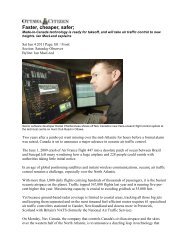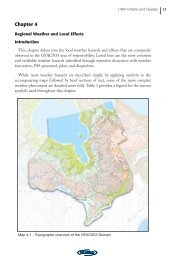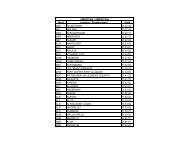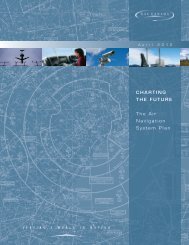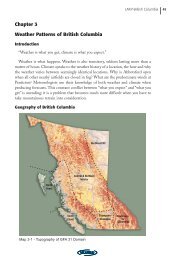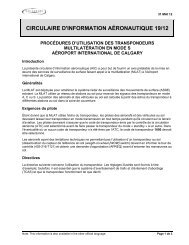Designated Airspace Handbook - Nav Canada
Designated Airspace Handbook - Nav Canada
Designated Airspace Handbook - Nav Canada
You also want an ePaper? Increase the reach of your titles
YUMPU automatically turns print PDFs into web optimized ePapers that Google loves.
© 2013 Her Majesty the Queen in Right of <strong>Canada</strong> Source of Canadian <strong>Airspace</strong> Data © 2013 Transport <strong>Canada</strong><br />
GLOSSARY OF AERONAUTICAL TERMS AND<br />
DESIGNATIONS OF MISCELLANEOUS AIRSPACE<br />
1. A point on the surface of the earth over which two or more position lines intersect. The position lines may<br />
be true bearings from NDBs (magnetic bearings shown on charts for pilot usage); radials from VHF/UHF<br />
NAVAIDs; centrelines of airways; fixed RNAV routes or air routes; localizers or DME distances; or<br />
2. The point where two runways, a runway and taxiway, or two taxiways cross or meet.<br />
LOW LEVEL AIRSPACE:<br />
All airspace within the CDA below 18,000´ ASL.<br />
LOW LEVEL AIRWAY:<br />
Controlled low level airspace, extending upwards from 2200 feet above the surface of the earth within the following<br />
specified boundaries:<br />
1. VHF/UHF airways based on VORs/VORTACs<br />
a) The primary airway width is 4 miles on each side of the centre line prescribed for such an airway<br />
b) Where applicable, the primary airway width shall be increased between the points where lines,<br />
diverging 4.5° on each side of the centre line from the designated facility, intersect the primary width<br />
boundary and where they meet similar lines projected from the other designated facility.<br />
2. LF/MF airways based on NDBs or VHF/UHF airways based on VOR/VORTAC and NDB<br />
a) The primary airway width is 4.34 miles on each side of the centre line prescribed for such an airway.<br />
b) Where applicable, the primary airway width shall be increased between the points where lines,<br />
diverging 5° on each side of the centre line from the designated facility, intersect the primary width<br />
boundary and where they meet similar lines projected from the other designated facility.<br />
Where the changeover point is not midway between the NAVAIDS, the airway includes the airspace between the<br />
system accuracy lines which extend from the farthest facility, at angles of 4.5° for VHF/UHF airways, 5° for LF/MF<br />
airways and 5° for VHF/UHF airways based on a VOR/VORTAC and NDB, to the changeover point and are joined<br />
by lines from the nearer facility.<br />
LOW LEVEL AIR ROUTE:<br />
Class G <strong>Airspace</strong>, extending upwards form the surface of the earth, within the following specified boundaries:<br />
1. Air routes based on VORs/VORTACs<br />
a) The primary air route width is 4 miles on each side of the centre line prescribed for such an air route.<br />
b) Where applicable, the primary air route width shall be increased between the points where lines,<br />
diverging 4.5° on each side of the centre line from the designated facility, intersect the primary width<br />
boundary and where they meet similar lines projected from the other designated facility.<br />
2. Air routes based on NDBs or a VOR/VORTAC and NDB<br />
a) The primary air route width is 4.34 miles on each side of the centre line prescribed for such an air<br />
route.<br />
b) Where applicable, the primary air route width shall be increased between the points where lines,<br />
diverging 5° on each side of the centre line from the designated facility, intersect the primary width<br />
boundary and where they meet similar lines projected from the other designated facility.<br />
Where the changeover point is not midway between the NAVAIDS, the air route includes the airspace between the<br />
system accuracy lines which extend from the farthest facility, at angles of 4.5° for VHF/UHF air route, 5° for LF/MF<br />
air route and 5° for VHF/UHF air route based on a VOR/VORTAC and NDB, to the changeover point and are joined<br />
by lines from the nearer facility.<br />
LOW LEVEL FIXED RNAV ROUTE:<br />
In low level airspace, a prescribed Area <strong>Nav</strong>igation track between specified fixes. For routes in controlled low level<br />
airspace, the airspace extending upwards from 2200 feet above the surface of the earth within the following<br />
specified boundaries:<br />
11<br />
DAH December 5, 2012 10:55 am<br />
DESIGNATED AIRSPACE HANDBOOK<br />
Effective 0901Z 10 JANUARY 2013 to 0901Z 7 MARCH 2013


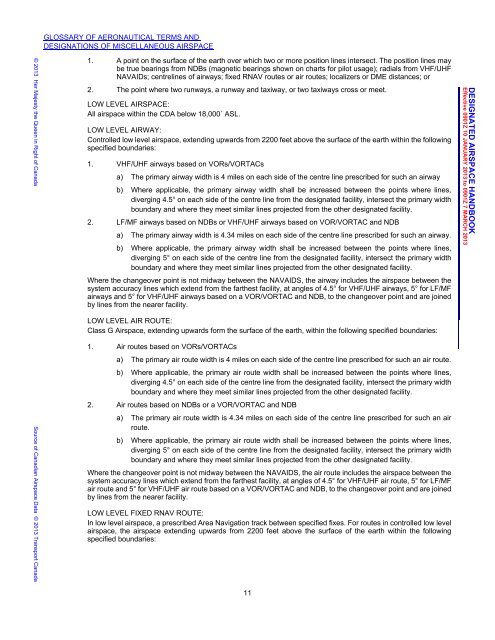
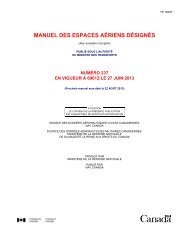
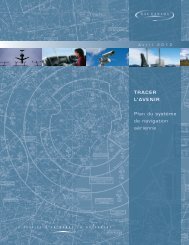

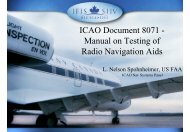
![[ cac ] canadian airport charts - Nav Canada](https://img.yumpu.com/12328212/1/190x252/-cac-canadian-airport-charts-nav-canada.jpg?quality=85)
